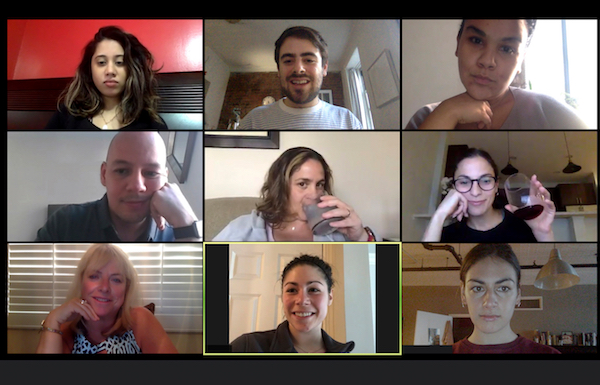A study by Sierra Tucson reveals a stunning increase in on-the-job drinking and drug use during this era of working remotely
By Mark Mravic
Most people would never think of cracking a beer or lighting a joint during a meeting in the conference room at downtown headquarters. But sitting alone in a home office or on a Zoom call where no one can see what’s just to the side of your laptop, the story might be different.
That’s the troubling takeaway from a recent survey of 1,000 workers commissioned by Arizona-based mental health treatment center Sierra Tucson. Put bluntly, the poll found that a surprising percentage of workers have taken advantage of pandemic-compelled remote work arrangements to drink and use drugs while on the job.
Among the findings of the survey, titled “Self-Medication Nation: The Numbing of America”:
- One in five remote workers (21%) said they used alcohol, marijuana or other recreational drugs during the workday
- A little over a quarter (28%) said the opportunity to use alcohol or recreational drugs was an added benefit of working from home
- 22% of employees said they’d participated in a Zoom or other virtual work call while under the influence of alcohol or recreational drugs
- 21% said they witnessed a colleague under the influence during a virtual meeting
- When asked why they preferred to work from home, 14% said it was because they could drink alcohol to relax during the workday, and 11% cited the freedom to use marijuana or other drugs to relax
Those figures will come as an eye-opener to any employer, and are of special concern to those in the treatment community. “As a manager of people and as a physician, I think substances are an absolute no-no when mixed with work,” says Jasleen Chhatwal, MD, chief medical officer at Sierra Tucson. “So to see that 20-plus percent of people were using recreational drugs during work hours was striking.”
Bottom line, what starts during work-from-home may well continue as employees return to their workplaces. Employers who truly care about the health of their employees must be ready.”
—Jasleen Chhatwal, chief medical officer at Sierra Tucson
Respondents gave a variety of reasons for turning to alcohol and pot at work during lockdown. While the bulk of users said they did it for enjoyment, significant percentages also cited stress (41%), anxiety (38%), depression (31%) and loneliness (20%). Two distinct groups of workers were identified as more inclined to use substances during stay-at-home orders: young-adult women (18-35) and mid-career men (35-50). “Typically, those are groups that find a lot of social value at work, places that they might connect and find meaning,” says Chhatwal, “whereas maybe, say, younger men still have other things in which they find some connection.”
The results aren’t just concerning because of what’s going on at home during the remote workday. They also mean employers face additional challenges as staffers return to the office, either full-time or in a hybrid model. The danger is that workers may bring inappropriate behaviors into the office when they return.
“Bottom line,” says Chhatwal, “what starts during work-from-home may well continue as employees return to their workplaces. Employers who truly care about the health of their employees must be ready.”
Remote Work: The New Normal?
As offices and other businesses shuttered during lockdown, millions of Americans found a new way to do their jobs: from home, in sweatpants. Driven by the COVID-19 pandemic, a wide range of people—from lawyers, teachers and financial planners to customer service reps and even doctors—took to remote work. The appeals of the arrangement are many: fewer interruptions; a quieter, more comfortable work environment; time and money saved on commuting, clothes, fuel and food; and most of all, perhaps, a sense of freedom and flexibility. Employers too, get something out of it—from reduced office costs to potentially higher productivity and a workday not necessarily confined to the 9-to-5 regimen.
Even when the pandemic recedes, remote work appears to be the wave of the future. In a survey by Flexjobs.com last spring—one year into the pandemic—58% of respondents said they would prefer to work remote full-time moving forward, and another 39% would want a hybrid work arrangement. (If you’re doing the math, that’s 97%, or basically everybody.) A study by the Partnership for New York City found that in October 2021 only 8% of Manhattan office workers were onsite five days a week, and 54% were still fully remote. While those numbers should rise in 2022, it’s clear that for occupations suited to it, remote work in some form is here to stay.
But as Sierra Tucson’s survey reveals, the freedom and flexibility of remote work may enable drinking or using substances use while on the job. An office can feel like a stifling environment for some employees, but it does provide structure, boundaries and in-person connections. Remove those, and the temptation will be there to indulge in behavior that would be otherwise inappropriate in a work setting.

Proactive Solutions
The new work model clearly poses significant challenges for employers. But there are steps to take. First and most foremost, says Chhatwal, is “setting expectations upfront about what is and is not okay during work hours.” She suggests facilitating more consistent check-ins among workers, to provide connection during the day. Additionally, she says, employers should be looking to have “more candid and authentic discussions around stress, workload and balance in work, making jobs fit better with the people who are doing them, and making it so that employees are not trying to escape work by using [alcohol or drugs].”
Indeed, if anything, the pandemic has highlighted the vital importance of face time with others, both inside and outside the work setting. “Even though people may like some of the benefits of working from home,” Chhatwal says, “you don’t have the same amount of connection you would have to your colleagues when you’re sitting down the hall or in the next cubicle. Quarantines typically do lead to increases in mental distress, because we’re such social animals. It’s just not quote-unquote normal for us to not be around people and be isolated.”
As staffers do return to the office, employers should be looking at the work environment—and perhaps incorporating some of the features that make working from home attractive. “I like to think about how to make the workplace a part of our wellness,” says Chhatwal. “If you have these really drab cubicles or offices that have no sunlight, and buildings that are just dreary, then you can see why people don’t want to be in the workplace.” Businesses, she says, should be “finding ways to enliven the workplace and have clear room for interaction, so that that connection that can be experienced while working at the office can become a positive for people to actually want to come in and work.”
The burden isn’t just on employers, of course. It’s incumbent on remote workers as well to adjust to the new paradigm. Again, Chhatwal says, consistent check-ins are key—but workers should be honest with themselves and their colleagues. “For some people, the automatic response when somebody asks, ‘How are you doing?’ is just to say, ‘Okay,’ without truly taking time to think about it.”

It’s important, she says, to start “from the point of checking in with oneself and coming to the awareness of how you are doing, and to be able to ask for help in a more proactive way. That’s where employees can ask employers right up front what supports are available to them, being able to keep that dialogue open with our managers about what we need to be successful and be healthy. Because it looks different for different people. Nobody on the outside can predict or tell us what would be good for us.”
That proactive approach extends to the structure and environment of the home office. Workers can reduce stress, anxiety and the effects of isolation by establishing a comfortable and engaging work set-up and taking regular breaks for physical and mental health, which may take the form of journaling, meditation or just checking in with friends and loved ones over the course of the work week.
“As employees, we should do a pros-and-cons list ourselves to figure out whether we are somebody who would benefit from getting dressed in the morning and going to work or, with our lifestyle and how we like to function, working from home is a true positive,” Chhatwal says. “At the end of the day, our health is a personal responsibility as well.”
For the Treatment Community, Work Ahead
On top of the eye-opening work-from-home findings, the survey also affirmed the general pandemic trend toward increased drinking and drug use. Among respondents who drank, more than a third said they increased their alcohol consumption, and the large majority of those said the increase was between one and three drinks per day. That adds up to as many as 21 additional drinks per week. (The National Institutes on Alcohol Abuse and Alcoholism defines heavy drinking for men as four drinks a day or 14 in a week, total.) Among marijuana users, 58% said they increased their use of pot during the pandemic.
Moreover, only 13% of the survey’s respondents reported seeking mental health therapy during the pandemic. Instead, alcohol and drug use have seemingly become coping mechanisms for the stress and anxiety of the pandemic.
Heavy drinking while people are isolated, working from home, etc., is going to require heavy lifting to solve. That’s a lot of treatment to be done probably in a short period of time.”
—Sean Kerwin, program manager at Sierra Tucson
For treatment professionals and employers alike, those numbers should ring alarm bells. All the more reason to become proactive in identifying people who may be struggling with the new normal. With an uptick in employer referrals to treatment, Chhatwal says Sierra Tucson has made its licensed professionals program more robust and is facilitating more in-person connections with clients, including an alumni program called Connect 365 that provides a year of coaching after individuals leave Sierra Tucson.
“Heavy drinking while people are isolated, working from home, etc., is going to require heavy lifting to solve,” says Chhatwal’s colleague Sean Kewin, MA, LPC, NCC, program manager at Sierra Tucson. “That’s a lot of treatment to be done probably in a short period of time.”
Top photo: Shutterstock; middle photo: Christana@wocintechchat.com














